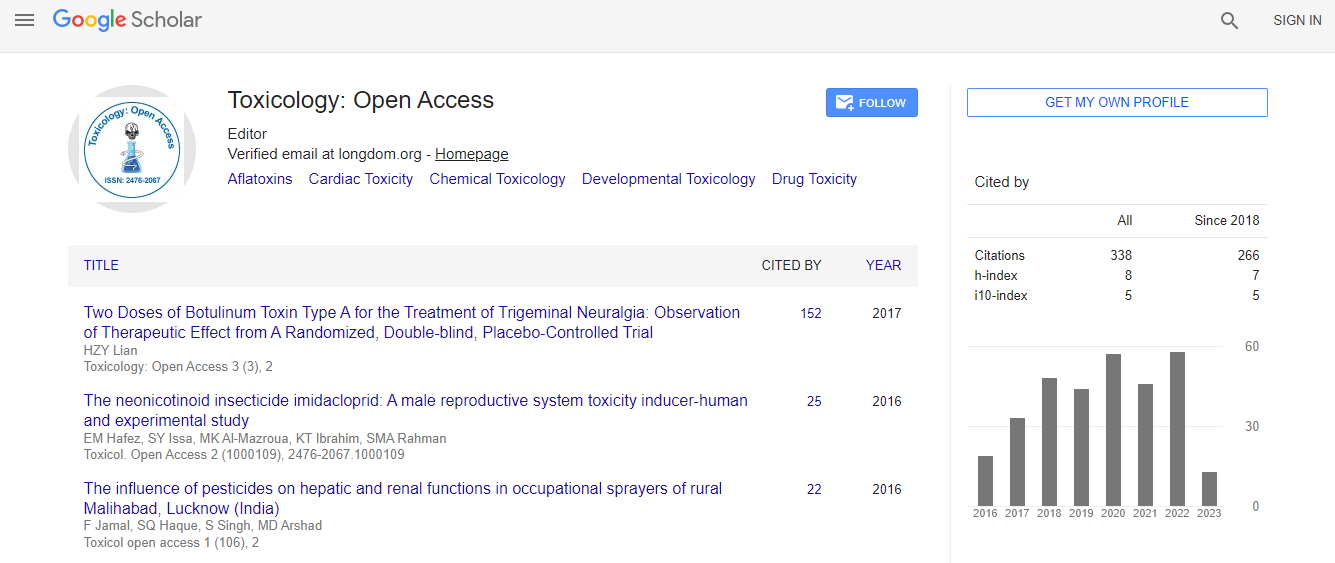Our Group organises 3000+ Global Conferenceseries Events every year across USA, Europe & Asia with support from 1000 more scientific Societies and Publishes 700+ Open Access Journals which contains over 50000 eminent personalities, reputed scientists as editorial board members.
Open Access Journals gaining more Readers and Citations
700 Journals and 15,000,000 Readers Each Journal is getting 25,000+ Readers
Google Scholar citation report
Citations : 336
Toxicology: Open Access received 336 citations as per Google Scholar report
Indexed In
- Google Scholar
- RefSeek
- Hamdard University
- EBSCO A-Z
- Geneva Foundation for Medical Education and Research
- Euro Pub
- ICMJE
Useful Links
Related Subjects
Share This Page
Nicotine attenuates concanavalin A-induced hepatic injury by regulating Kupffer cells in mice
14th World Congress on Toxicology and Pharmacology
Jing Qi, Jing Zhao, Hyuneui Jeong and Bumseok Kim
Chonbuk National University, South Korea
Posters & Accepted Abstracts: Toxicol Open Access
Abstract
Nicotine, a major constituent of cigarette smoke, is a potent parasympathomimetic alkaloid found in the nightshade family of plants. Acute liver failure (ALF), known as a rapid and severe clinical syndrome, can induce multiple organ dysfunction and failure. This study aimed to investigate the effects of nicotine on concanavalin A (Con A) induced autoimmune hepatitis in mice and to elucidate its underlying molecular mechanisms. Autoimmune hepatitis was induced by the intravenous administration of Con A (15 mg/kg) to healthy BALB/c male mice and nicotine (0.5 mg/kg and 1 mg/kg) was intra-peritoneally injected before the challenge with Con A. Eight hours later the mice were euthanized and blood and tissues were collected for analysis. The present study showed that nicotine pretreatment significantly decreased the elevated serum alanine aminotransferase (ALT) and aspartate aminotransferase (AST) and ameliorated hepatic pathological damage and necrosis. In addition, nicotine treatment markedly suppressed the secretion of pro-inflammatory cytokines and chemokines including tumor necrosis factor-a (TNF-a), interferon (IFN)-�³ and interleukin (IL)-4. Furthermore, nicotine down-regulated the activation of NF-kB signal in Con A-treated mouse livers. Since Kupffer cells have been known as a crucial component in the initial part of pathogenesis of ALF, our present study confirmed that depletion of Kupffer cells by liposomal clodronate abolished the protective effects of nicotine against Con A-induced hepatitis, as shown by the similar levels of serum aminotransferase levels and pro-inflammatory cytokines with or without nicotine treatment in Con A treated mouse livers. In the primary Kupffer cells, nicotine ameliorated inflammatory cytokines and regulated the expression of NF-kB signal. Consistent with the above findings, this study suggested that nicotine could attenuate Con A-induced autoimmune hepatitis and possible mechanism might be associated with the inhibition of Kupffer cells activation through NF-kB signal pathway. Recent Publications 1. Park S, Kim JW, Yun H, Kim B (2016) Mainstream cigarette smoke accelerates the progression of nonalcoholic steatohepatitis by modulating Kupffer cell-mediated hepatocellular apoptosis in adolescent mice. Toxicology Letters; 256: 53-63. 2. Yang Q, Liu Y, Shi Y, Chen Z (2013) The role of intracellular high-mobility group box 1 in the early activation of Kupffer cells and the development of Con A-induced acute liver failure. Immunobiology; 218(10): 1284-92. 3. Kimura K, Tanida M, Nagata N, Inoue H (2016) Central Insulin Action Activates Kupffer Cells by Suppressing Hepatic Vagal Activation via the Nicotinic Alpha 7 Acetylcholine Receptor. Cell Reports; 14(10): 2362-74. 4. Schwabe RF, Brenner DA (2006) Mechanisms of Liver Injury. I. TNF-alpha-induced liver injury: role of IKK, JNK, and ROS pathways. American journal of Physiology-Gastrointestinal and Liver Physiology; 290(4): G583-9Biography
Jing Qi is a currently pursuing MBBS in Veterinary Pathology from Chonbuk National University of South Korea and has completed her Master’s degree of Veterinary Medicine in China in June 2016. She is mainly researching on hepatotoxicity induced by medicine or metabolism in the mouse model.
Email:qijingvet@163.com

 Spanish
Spanish  Chinese
Chinese  Russian
Russian  German
German  French
French  Japanese
Japanese  Portuguese
Portuguese  Hindi
Hindi 